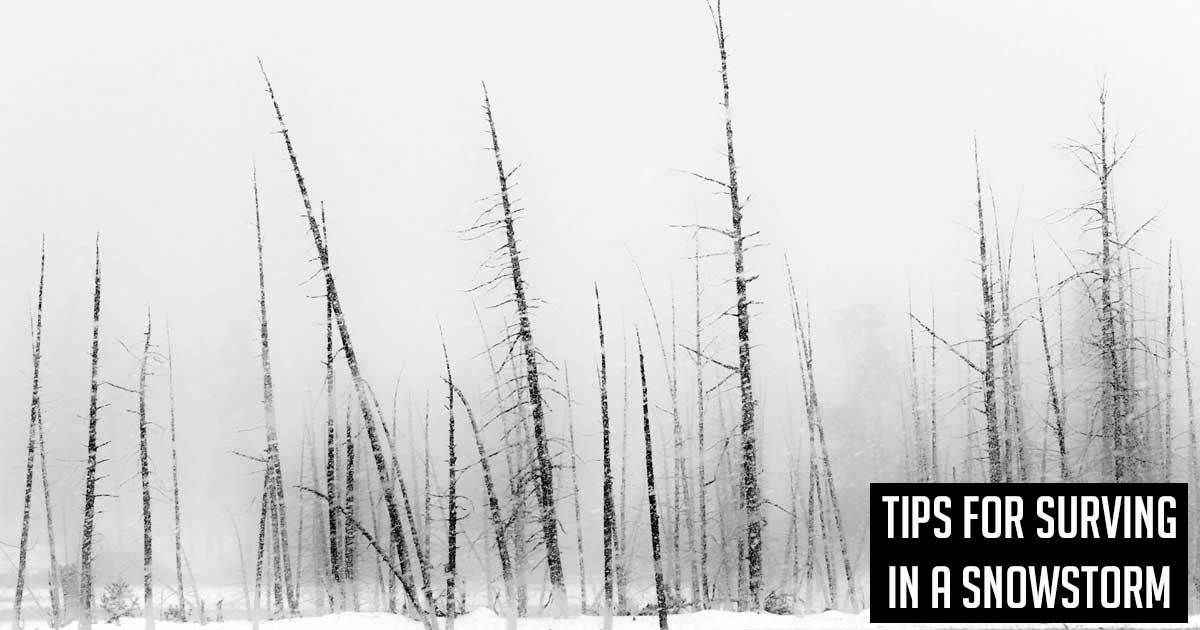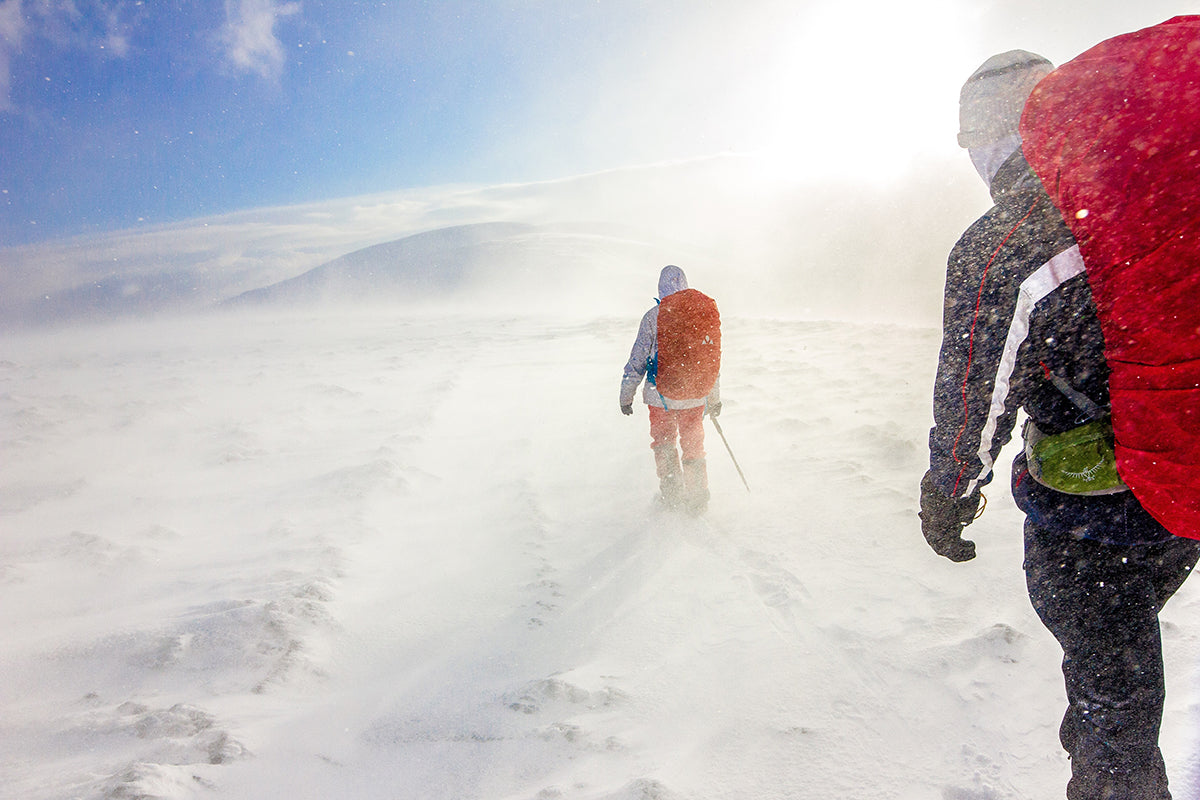Winter weather can be lovely: There’s not much prettier than big, feathered snowflakes lazily falling in a frosted forest. But it can also be ferocious. Enter: the snow storm.
Whether you’re into winter sports and recreation or simply hunkering down for the season at the old domicile, preparation for winter weather is vital. Here we’ll run down some of the basics of winter storm survival: at home, in the car, and out-and-about in the backwoods or mountains.

Winter Storm 101: Hazards & Terminology
Whether you’re headed out into the wintry woods on snowshoes or skis, or you’re packing the car for a holiday trip, an easy but critical step is studying the weather forecast. It’s better to reschedule or cancel plans if severe winter weather is likely.
You should definitely familiarize yourself with theNational Weather Service’s terminology regarding winter meteorology. First off, you’ve got the different types of weather events: freezing rain, ice storms, winter storms, blizzards, and the like. Then there are the forecast categories themselves:advisories,watches, andwarnings.
Lake-effect blizzards and frontal ice storms are dramatic and all, but active precipitation is by no means a prerequisite for dangerous winter weather. Wind can plunge the effective temperature by whipping away body heat (the windchill effect). It can also stir up unconsolidated snow to form a so-called “ground blizzard,” which often occurs when snow has fallen and temperatures have remained well below freezing: Without some degree of melting to consolidate a snowpack, the white stuff remains powdery and easily stirred by even moderate breezes. In such a scenario, even under friendly blue skies, a snowshoer or cross-country skier may find themselves completely disoriented, and a highway may disappear in a dicey whiteout.

Winter Storm Survival at Home
A blizzard or ice storm can knock out power for hours or days. A snow power outage is a serious situation given the cold temperatures, so it’s essential to outfit your home with the necessary supplies. We’ve written about prepping for and weathering a long-term power outage here at the Mountain House blog before, sobone up on the basics of how to survive without electricity.
One winter-specific risk of a power outage is frozen water pipes. It’s a good idea to insulate your pipes as a precautionary measure. If the power’s out, you can prevent freezeup by letting your taps drip slightly; everyone in the household should (of course) also know how to shut off the main water supply in the event a pipe does burst.
Another smart preventative measure to winterize your home is having your roof assessed for structural integrity: Heavy snow loads can collapse unsound roofs.
It goes without saying that a fireplace or woodstove comes in super-handy during a winter power outage. If you don’t use yours regularly, consider keeping a stockpile of dry, seasoned wood on hand in case of a storm blackout. Besides keeping you warm when the furnace is dead, a fireplace or woodstove also serves as a means of cooking food. It can also help you boil water (convenient—though ultimately not essential—for preparing a Mountain House meal); for more info, check out our recent blogpost on boiling water without electricityright here.
Never use a cookstove, grill, or generator inside. Make sure your house has carbon monoxide detectors installed on each floor and outside sleeping rooms, and test them regularly to ensure they’re working. The same goes for smoke alarms, of course.

Camping in a Blizzard
What should you do if you are caught in a snow storm out in the wilds? Any winter recreationist—snowmobilers, snowshoers, cross-country/backcountry skiers, mountain climbers, etc.—should be prepared for the possibility. That means carrying the Ten Essentials of wilderness safety, including fire-starting materials, warm clothing, backup food, and emergency-signaling tools.
It’s safest to hunker down during a blizzard: Besides the soaking snow and dangerous windchill you may be exposed to, navigation in such a maelstrom is challenging at best, if not impossible. A four-season tent offers some protection, but in a heavy and prolonged snowstorm, you may want to consider making a warmer, sturdier shelter that doesn’t require regular brushing-off.
This underscores the value of carrying a lightweight snow shovel in your seasonal pack, and perhaps also a snow saw. Such tools make it feasible to fairly quickly excavate a snow cave: an absolute lifesaver in a bad storm. Learning how to make a snow cave, which means practicing the process in non-emergency situations, is an excellent idea for anybody who does a lot of outdoor recreation in wintertime. As with so many survival skills, it’s definitely not the sort of thing you want to try for the first time when you actually need it, and an improperly constructed snow cave may collapse on its occupants.
Snow caves are dug out of slopes: whether a hill- or mountainside or the flank of a large snowdrift. The steeper the slope, the better, but for obvious reasons you should avoid avalanche-prone terrain. You’ll dig an entrance tunnel and carve out a raised interior with ventilation holes. The roof of the cave should be at least two feet thick, and its ceiling should be domed and sculpted as smooth as possible to minimize meltwater dripping. The interior dimensions depend on the number of people who’ll be sheltering within, but remember a smaller cave will be a warmer one.
If the weather’s firmly below freezing, you may also opt to build an igloo, more challenging and time-consuming to make than a snow cave but under appropriate conditions very stable and durable, and an option on flat terrain.
Armed with a shovel, you also have rougher-and-readier options for snow shelters if terrain, conditions, or your own skill level don’t permit cave- or igloo-construction. You can dig out a trench, for instance, and roof it with a tarp pinned down by snow or, better yet, an A-frame of snow blocks.
Depending on where you are, of course, you may be able to take advantage of natural shelters: a cave or alcove, for instance, or a conifer whose low-spreading boughs you can dig beneath. If you are digging out a snow shelter against a tree or other natural setup, make sure the snow is of adequate stability and thickness to prevent unwelcome (and maybe worse) structural failure.
What to Do in a Blizzard When Driving
Driving in whiteout conditions can be extremely dangerous: More than 6,000 people per year die in weather-related crashes in the United States on average, the National Weather Service reports, and hundreds of thousands sustain injuries. You should pull over and wait out the storm if visibility is bad. An ice storm presents its own hazardous conditions for motorists; black ice is extremely slick yet effectively invisible. When temperatures drop to around freezing, be particularly cautious driving across bridges and overpasses, where ice tends to form first.
Whether you’re pulled over on the highway or you’ve become stranded on some impassable backroad due to heavy snow or treacherous ice, your best bet is almost assuredly staying with your vehicle. Run the engine for roughly 10 minutes per hour to stay warm, during which you should crack the window a hair for ventilation. Regularly check your exhaust pipe to make sure it’s clear of snow; carbon-monoxide poisoning is a real hazard.
At night, turn on your dome light during your 10-minute intervals of running the engine so you’re visible to other vehicles and, if the case may be, rescuers. You can also increase your visibility (if you’re genuinely stranded and in need of rescue) by tying a red or otherwise bright-colored cloth to your car antennae.
On this subject, it’s critical to winterize your vehicle (just like your home) ahead of the cold season. Inspect each component of the system, or take it to a mechanic, to ensure everything’s in good working order and that fluid levels are adequate. Carry chains or install snow tires, and keep sand in your car in case you need it as an additional traction aid. Your car should have an emergency kit regardless of the season, but for winter travel make sure it includes warm blankets, an ice scraper, and a candle and matches or a lighter.
More Resources
To learn more about snow storm survival, check out these web pages:






















































